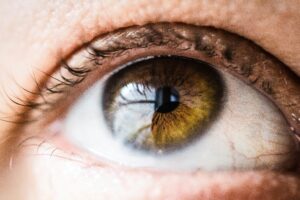By Isobel Andrews

In November 2024, toxic wildfire smoke from a devastating fire in parts of New Jersey and New York triggered an air quality health advisory, impacting millions across the New York metropolitan area. Residents of Rockland and Westchester counties were among those affected as pollution levels—measured by ozone and fine particulate matter (PM2.5)—exceeded an air quality index value of 100. This alarming event highlighted the escalating threat of climate change to public health, underscoring the urgent need to address its effects on eye health.
While the long-term effects of exposure to pollutants like wildfire smoke remain unclear, studies confirm that eye irritation is one of the most commonly reported symptoms. Conditions such as dry eye disease and conjunctivitis have also been linked to air pollution exposure. However, the risks to New Yorkers’ eye health extend beyond wildfires. Rising temperatures, UV radiation, and industrial pollution also pose significant threats. Here’s a closer look at these environmental issues and actionable steps to protect your vision.
Wear sunglasses to shield the eyes from UV rays
The New York State Department of Environmental Conservation predicts a sharp increase in days exceeding 90° Fahrenheit by 2050, alongside more frequent and prolonged heat waves. This rise in temperatures amplifies UV radiation exposure, which can damage the eyes. UV rays are linked to cataracts, macular degeneration, and photokeratitis (a painful sunburn of the eye). Prolonged exposure can also accelerate aging of the skin around the eyes and lead to vision impairment.
Wearing sunglasses is one of the most effective ways to safeguard your eyes from harmful UV rays. When selecting sunglasses, look for lenses that block 100% of UVA and UVB rays. For those requiring vision correction, prescription sunglasses are an excellent option. Brands like Oakley and Ray-Ban, available through Sunglass Hut, carry high-quality frames like the Holbrook XL, which not only provide full UV protection but can also be customized for single-vision or progressive lenses. Plus, the larger lenses offer additional protection by shielding your eyes from peripheral sunlight.
Use artificial tears after exposure to wildfire smoke
Fall 2024 was among the driest seasons on record in New York, creating conditions ripe for wildfires. Experts caution that while East Coast wildfires are unlikely to match the intensity of those in the West, periodic droughts will continue to increase fire risks. As we mentioned earlier, wildfire smoke poses significant challenges to eye health. Ophthalmologist Dr. Marisa Sit explains that smoke contains particulate matter and volatile organic compounds that irritate the eyes. Symptoms such as dryness, itching, redness, and grittiness can occur even before smoke becomes visible.
To mitigate these effects, use lubricating eye drops or artificial tears. These drops refresh and hydrate the eyes, helping to wash away irritants. Look for preservative-free formulations like the Systane Hydration Preservative-Free Lubricant Eye Drops, as these are gentler for frequent use. Moreover, Systane’s eye drops contain hyaluronic acid for enhanced moisture retention.
Undergo regular eye exams to maintain vision health
Living near industrial sites in New York exposes residents to additional pollutants, including nitrogen oxides, sulfur dioxide, and fine particulates. These emissions degrade air quality and can trigger a range of eye issues. According to an article from News-Medical.net, these can include burning sensations, watering, discharge, and increased susceptibility to infections. Over time, exposure may contribute to cataracts, retinal damage, and other serious conditions.
Regular eye exams are essential for detecting and treating these issues early. The American Optometric Association recommends comprehensive eye exams every two years for adults under 65. Older adults and individuals at higher risk for eye conditions should schedule annual checkups. During these exams, your eye care provider can identify signs of environmental damage, suggest protective measures, and offer tailored treatments to maintain optimal vision health.
As New York faces mounting environmental challenges, it’s crucial to adopt protective measures for your eye health. By wearing sunglasses, using artificial tears, and undergoing regular eye exams, you can minimize the harmful effects of pollution and UV radiation. These proactive steps ensure that your vision remains clear and healthy, no matter the environmental risks.







